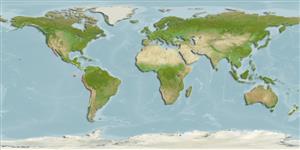>
Eupercaria/misc (Various families in series Eupercaria) >
Labridae (Wrasses) > Bodianinae
Etymology: Bodianus: Bodianus after Bodiano or Pudiano, from the Portuguese pudor, meaning modesty (Jordan & Evermann, 1896).; eclancheri: Named for M. L’Eclancher (Ref. 75973).
More on author: Valenciennes.
Environment: milieu / climate zone / depth range / distribution range
Écologie
marin récifal; profondeur 5 - 46 m (Ref. 5227). Tropical
Southeast Pacific: Ecuador to central Chile. Originating in the Peru-Chile Province, it is found in the cooler waters of the Galapagos Islands.
Taille / Poids / Âge
Maturity: Lm ? range ? - ? cm
Max length : 61.0 cm TL mâle / non sexé; (Ref. 5592); common length : 40.0 cm TL mâle / non sexé; (Ref. 55763)
Body moderately deep and compressed; head large and pointed; teeth elongate and compressed, resembling incisors; dorsal fin contiguous, with 12 spines; posterior rays of dorsal and anal fins forming filamentous lobes; lower branch of first gill arch with 9 to 10 gill rakers; variable, depending on size and sex; body brown, black, red or orange, but less than 5 percent of the population is entirely black (Ref. 55763).
A sequentially protogynous hermaphrodite. In the Galapagos, the colorful appearance may be due to selective pressures and their increased feeding and decreased reproductive activities may serve to avoid extraordinary predation (Ref. 9227). Adults forage on a wide range of invertebrates and algae (Ref. 28023). Oviparous, distinct pairing during breeding (Ref. 205).
Life cycle and mating behavior
Maturité | Reproduction | Frai | Œufs | Fécondité | Larves
Pelagic spawner (Ref. 32168). Oviparous, distinct pairing during breeding (Ref. 205). Also Ref. 103751.
Merlen, G., 1988. A field guide to the fishes of Galapagos. Wilmot Books, London, England 60 p. (Ref. 5590)
Statut dans la liste rouge de l'IUCN (Ref. 130435)
Menace pour l'homme
Harmless
Utilisations par l'homme
Warning: mysqli::__construct(): (HY000/1040): Too many connections in /var/www/html/includes/func_getlabel.php on line 46
Can't connect to MySQL database (fbapp). Errorcode: Too many connections
